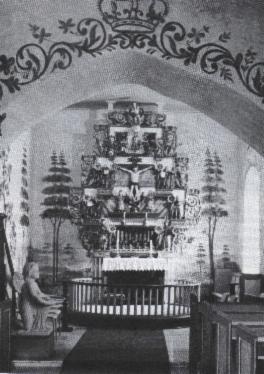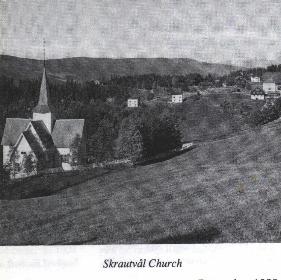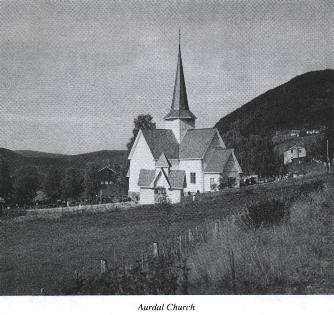Ulnes, Strand, Skrautval, Aurdal, Aurdal Mountain Church, Tisleidalen, Tingnes
By Jahn Børe Jahnsen
There are four old churches in North Aurdal: Ulnes, Strand, Skrautvål and Aurdal. These are churches which today look the same as when your ancestors left for America during the last half of the last century. In addition there are three newer churches: Aurdal mountain church, Tisleidalen and Tingnes, all built after your ancestors left.
The Ulnes church is the oldest church in North Aurdal, and the only medieval church in the commune. Ulnes church is the youngest of three medieval stone churches in Valdres, the two other being the Slidre church from 1170 and the Mo church ruin from 1215, both in West Slidre. In the Ulnes Church some of the details of construction in the windows, doors, roof construction, etc can be typed as Romanic and Gothic. Since the transition from the Romanic to the Gothic style mostly dates back to sometime around 1250, we believe that the Ulnes church also dates from around 1250. The church is mentioned for the first time in 1307 and then again in 1327. The parish of Ulnes is mentioned many times during the Middle Ages, but we only know of one medieval parson in Ulnes and that was Bjøm in 1322. The Ulnes church began to decay after the Reformation in 1536. Old documents tell us that the walls had to be supported by wooden posts in 1623. In 1686 it was suggested that the old church should be taken down and replaced by a wooden church. But in 1735, when the church had been out of use for 20 years, it was finally rebuilt and restored for the most part in its medieval stone form. The church later was repaired again in the 1890s and 1950s. The bell tower is from 1735, while the wooden parts of the building (entrance and sacristy) were added in 1892. The Ulnes church has a rich interior. An altar front piece (now in the Museum of Antiquities in Oslo), a door-ring, a pyrmide like top of a baptismal font, and one of the bells in the tower are all from the Middle Ages. The fresco paintings in the choir are from the 1790s, painted by the famous Valdres rosemaler (rosepainter) Ola llermundson Berge.

The altar piece is from 1850, made by two brothers, Anders Pederson Rye, a wood-carver, and Halvor Pederson Rye, a painter. The story about the altar piece is interesting: In 1847 the two brothers decided to immigrate to America. Their ship sunk in a storm in the North Sea and all the passengers went into lifeboats. They feared for their lives. The brothers prayed to God that if they survived, they would go home and make a nice present to their old church. At long last the lifeboat was washed ashore in Holland. The two brothers stayed for some years in Holland and Germany. As artists they picked up a few ideas that were useful when they came home to Ulnes and began the work on the altar piece. One can trace the German influence in many parts of the altar piece. The Rye brothers, however, did not forget their dream of America and finally left Nor-way in the 1860s. Just this September I showed American descendants of the Rye brothers around Ulnes church. There are two baptismal fonts in the Ulnes church, both in the form of an angel. The oldest, in wood, is from 1793, a gift from Engebret Gudbrandson and Marit Eivindsdotter, Upper Ulnes. The youngest, in plaster, is a gift from the famous sculptor Ole Fla-dager, who was born in Ulnes 1832 and died in Rome, Italy 1871. Many other interior pieces and furniture are gifts from or made by people from Ulnes or from people in the United States or Canada with family roots in Ulnes (that is, the Brujords in the United States and Stavenjords in Canada).

The Strand church is just some miles west of Fagemes. The official name of the church is “The Svenes Church at Strand” and the parish is Svenes parish. But in daily conversation one only speaks of the Strand church. The Svenes church close to Ulnes church is mentioned first in 1307 and 1327. Both the parish and the parson are mentioned many times during the Middle Ages. At that time the church was a stave church of which we know almost nothing. It seems that the stave church first burned down and then was rebuilt. Then in 1703 this stave church was too small for the growing congregation and was taken down. It was replaced by a timberlog church, which was standing at Svenes until 1859-1860, when it was moved to a more central place in the parish at Strand where it still stands. Some parts of the church had to be renewed when it was moved. When it was standing at Svenes, a former parson described the church as looking “more like a cow house than a church”. Today the Strand church is a beautiful white church overlooking the lake. The only thing left from the Middle Ages is a door-ring on the south door. The pulpit dates from Renaissance time in the 1600’s. The baptismal font was carved by the famous woodcarver Thomas Blix (1677-1729). The altar piece is a modem one made by Olav Rudi of Valdres.Skrautval Church

At the place where the Svenes church once stood before being moved to Strand, there is now a memorial stone for the old church. (See Budstikken December 1987, page 25.) The Skrautvål church is some miles north of Fagemes. The first parson in Skrautvål is mentioned in 1311 and the church is mentioned in 1327, but it must have been built before 1300. At that time the Skrautvål church was a stave church, which existed until about 1760. It was then taken down because it was too small and old and a new timberlog church was built higher up in the hillside. This new church, inaugurated in 1785, still exists. A door-ring and some other artifacts are from the old church. The baptismal font is medieval. The altar piece is made by the woodcarver Kvite-Sjugurd and the famous rosepainter Ola Hermundson Berge around 1795. The pulpit was painted by the same Ola Hermundson Berge. In the Skrautvål parish there are legends about a small medieval stave church or chapel at the Sørhus farm. This chapel is mentioned in 1327 and it seems it was taken down between 1733 and 1744. The story tells that only up to 20 people could be seated in the Sørhus chapel, of which nothing exists today. There are also legends about a church at Kyrkjesletta east of Skrautvål, but here we have absolutely no details.

The Aurdal church is mentioned for the first time in 1327, but experts say it must have been built sometime around 1250. At that time it was a stave church, of which some beams or staves exit today under the floor of the present Aurdal church, which was built in 1735. The present Aurdal church is, like the Strand and the Skrautvål churches, a timberlog cruciform church. Inside the church we find a medieval baptismal font and a canopy from 1658. The beautiful pulpit and altar piece are both the works of the famous rosepainter Ola Hermundson Berge, made around 1795.Aurdal Church
The Aurdal church is today the main church in Valdres, one could say the present “cathedral” of Valdres, where the Dean of Valdres resides. The Dean of Valdres is the Bishop’s representative in Valdres and at the same time the head of all parsons and pastors in Valdres.
These are the four old churches in North Aurdal. Churches which existed when most of the emigrants left for America. These are churches which your ancestors may have visited before leaving their homeland. But there are also three newer churches in North Aurdal worthwhile mentioning.
The Aurdal Mountain Church was inaugurated in 1966. It is situated in the mountain and forest area east of Aurdal, where there are hotels and many weekend huts for people from the cities.
The Tisleidalen church was inaugurated in 1958. It is situated close to the main road over the mountains from Valdres to Gol in Hallingdal. This is a church mostly for the inhabitants of the Tisleidalen mountain valley, but it is also for hotel guests and city people visiting their huts.
The Tingnes church was inaugurated in 1972 as a church for the two small towns Fagemes and Leira. When the population of these two towns grew, a new church had to be built. It was decided to build it between the two towns and to choose the neutral name of Tingnes, the name of the small peninsula in the lake. The church has an unusual triangular form with rooms for many activities.
Reprinted with permission from the Budstikken, December 1999.